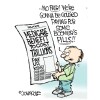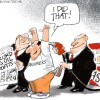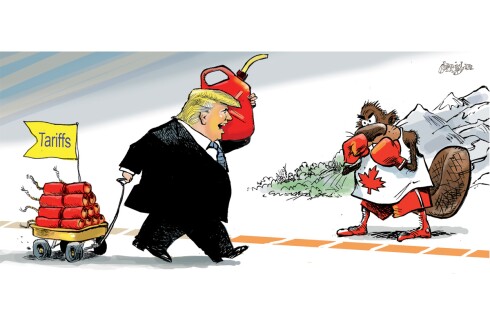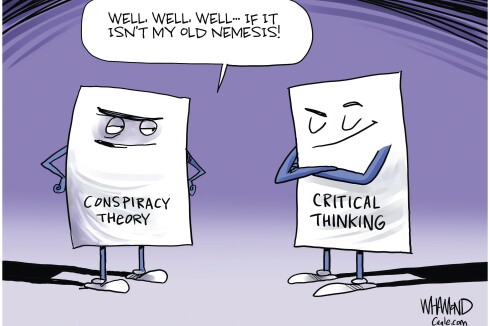At a community luncheon last week on public safety in our downtown, an office worker described how, at the end of every day, a group appearing to be homeless invades the elevator area near where she works to do drugs and to hang out.
“I need to know what we can do to deter them from coming and taking over our area. They’re disrespecting our location, and they’re also disrespecting each other and everybody else,” she said. “What can I do to protect myself?”
ADVERTISEMENT
Such questions are, sadly, becoming more common in downtowns in and well beyond Duluth, especially since the pandemic emptied city centers of workers and productive activity. While a transition to more downtown housing is now taking place, longtime urban challenges and problems stemming from mental illness, homelessness, drug use, and crime continue to persist.
Ongoing difficulties are precisely why the group Downtown Duluth organized the luncheon, inviting Police Chief Mike Ceynowa, Fire Chief Shawn Krizaj, Downtown Duluth Outreach Specialist Nathan Kesti, and St. Louis County Public Health and Human Services Director Linnea Mirsch to come and be grilled, to offer their perspectives, and to help brainstorm solutions.
The bottom line from the public-safety leaders who see and who work every day with the issues: it’s complicated, with no easy answers.
And sometimes it feels like “playing Whac-A-Mole,” to repeat the comparison used by Outreach Specialist Kesti.
Last summer, for example, police increased patrols along downtown sidewalks, only to see problems increase in alleyways. “That’s now where we’re finding needles and graffiti,” Chief Ceynowa said. As another example, in recent weeks, downtown’s four major parking ramps began to be locked down, and already there’s a noticeable uptick in calls in the skywalk system.
“How do we redirect those (activities) and not just move them to a new location?” Kesti asked. “How can we, like, redirect behavior and help people get the help they need?”
When police crack down in one place, a hot spot pops up somewhere else, Chief Ceynowa confirmed, a support of Kesti’s Whac-A-Mole analogy.
ADVERTISEMENT
Fortunately, many public-safety calls downtown aren’t violent or serious, the chief said. Most often they're things like unwanted persons, disturbances, minor damage to property, shoplifting, larceny from vehicles, and medical emergencies that may or may not involve drug use.
They’re nuisance things largely, but when citations are issued or arrests are made for trespassing or other misdemeanors, those nabbed quickly return to the streets. Ceynowa called it “kind of an in-and-out cycle.”
One not helped by some state and federal laws. In 2023, as one example, the Minnesota Legislature legalized the possession of drug paraphernalia, including needles and syringes. Many, consequently, are not disposed of properly or safely but instead are discarded, including on public sidewalks and streets where they pose a hazard.
Even a bit of good news divulged at the luncheon came with a Whac-A-Mole counterbalance.
In the past year, reports of overdoses in Duluth went down by about a third, Chief Ceynowa said. One downtown parking ramp that had 33 overdose calls in 2023 had zero last year, he said.
But much of that positive trend may be due to the increased availability and use of Narcan to treat overdoses in emergency situations, according to Fire Chief Krizaj. “People just don’t call 911 as much” when overdoses occur, he said. “Our numbers are actually down, (but) that doesn’t mean that overdoses, per se, are down.” Not necessarily.
Encouragingly, ensuring that those who need help get what they need and that Duluthians and visitors alike are safe and feel safe while downtown is being worked on by many entities. The chiefs, Kesti, and Mirsch all praised collaborative efforts, including with Chum , Stepping On Up , Union Gospel Mission , the business community, their own entities, and others.
ADVERTISEMENT
“I believe yes, we can fix this. But I think it doesn't just fall on one organization,” Outreach Specialist Kesti said. “Together as a community, we’re not giving up on our downtown. We’re not giving up on each other. Because when we run away from a problem, the problem evolves. … (We need to) work together and say we want a compassionate solution to what we are seeing.”
“It takes all of us, but it’s not just us,” said Chief Ceynowa. “It’s going to take the state and federal dollars as well to really look at the structural changes and the infrastructure needs.”
“There are good things that are happening,” Downtown Duluth President Kristi Stokes said.
That may be, but as long as anyone downtown feels compelled to ask what they can do to protect themselves, clearly, more attention, harder work, and ongoing community conversations are needed. Solutions may be complicated, but they can and demand to be found.
















